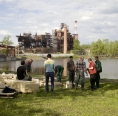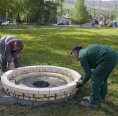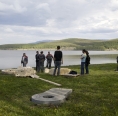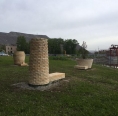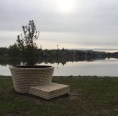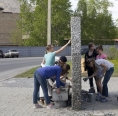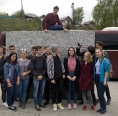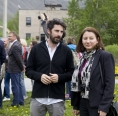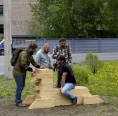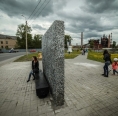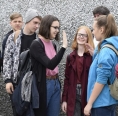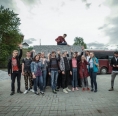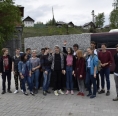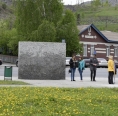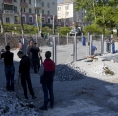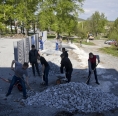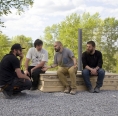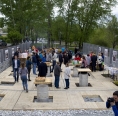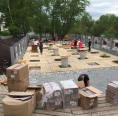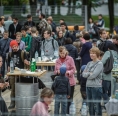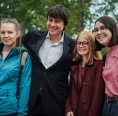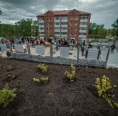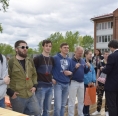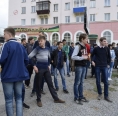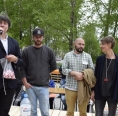-

The First Stage of My Satka 2017 Festival Completed
The first stage of My Satka 2017, festival of urban space planning, was completed in Satka (the Chelyabinsk Region). Since opening May 21, the festival hosted architects, designers and street artists from Russia, Switzerland and Italy, as well as city campaigners and volunteers with active engagement of local school and college students.
- This year, the festival reaches a new level, - Egor Larichev, the festival supervisor, explained. - The festival became long-term, the facilities became much more impressive; it’s the first time we have real opportunity to discuss them with the authorities and city campaigners, to specify design solutions in advance.
This year, the festival facilities were concentrated on two sites – the bank of the city pond in the old part of the city and Ruina space that arose at the place of the demolished residential house near Magnezit Cultural Center.
Both sites, as point of growth of urban environment design, were marked with wooden Sphinxes created in the workshop of the Satka’s carpenter, Tagir Abrarov, according to sketches of the Moscow architect Dima Baryudin. “A Sphinx that asks questions is a symbol of forthcoming changes”, – this is how the author, and also one of the festival visionaries, explains philosophical basis of his sculptural benches that city residents really liked.
Then, a concrete dolmen, sub-base for the future work of Swiss designer Dmitry Baler, appeared on the bank. During a week, the author and volunteers were decorating the stele with coin-size mosaic made of dolomite and magnesite pieces. The result was a large abstract double-sided stone bed – a gradient or some kind of abstract dawn transiting from black into white through grey.
After the official opening, the abstraction turned into the public taxi bus stop and became useful for people.
In the embankment of the city pond, a group of Swiss designers from Lausanne, Adrienne Rovero and Christoff Fuad, in collaboration with masters of Satka’s MMC, created the composition from giant pots resembling ancient ironwork furnaces – the main attraction of the Satka’s neighbour, Mezhevoy. These furnace pots are the site to grow from for the trees chosen by the gentle hand of the festival botanist Vera Merker, CEO of the botanic garden of the Chelyabinsk State University, a great patriot of the Ural flora.
At the very same time, in Ruina site, the project of Moscow architect from KONTORA bureau Igor Aparin was deployed as a fully-fledged installation. An amphitheater created the last year got further development in the form of two gabion walls – transparent wirework filled with coarse rock. Floor of the new urban space was surfaces with wooden palettes; later, the space will be supplemented with tables for chess and other board games. According to the architect’s idea, this space is intended to be made habitable by urban residents. That is why Ruina opening was accompanied by two events at a time – the Neighbor’s Fair and the exhibition of the Swiss architect and photographer, An-Lor Le Sha that was excited to catch peculiarities of the local architecture in the monumental photo format. The Neighbor’s Fair held on the occasion of the neighbors’ day celebrated globally in the end of May promises to become Satka’s annual celebration attracting ever more active city residents.
Besides, during the first stage of the festival that, according to Pavel Baranov, deputy head of the Satka Region and the festival idea driver, was recognized as success, Satka hosted the research group of urban architects from Samara Institute of Architecture and Construction under the supervision of Sergey Malakhov and Evgenia Repina.This being their first visit to Satka, the architects known with their conceptual and research approach to urban environment found Satka to be a beautiful and unique South Urals city, where the past is as interesting as the present and the future.
Other Space graffiti festival became a separate part of My Satka; this year the festival reached the international level – the participants included Nevercrew, a group of artists from Switzerland (Christian Rebekkee and Pablo Tony), Italian masters of street art, Solo and Diamond, and masters of monumental abstraction, Petro and Slak (Aesthetics Group) – Petr Gerasimenko and Ilya Blinov – from Zhukovsky town in the Moscow Region. A giant bear entangled in a red ribbon – a monumental part of Nevercrew’s Stripping Car diptych (actually, the car itself was painted on the transformer vault in another part of the city) metaphorically urges the city residents to open their eyes at the reality around them going beyond the system that “packs” their views and paints their thoughts in certain colours.
It is the second year that the urban development festival takes place in Satka with support of Sobranie Cultural Initiative Supporting & Preservation Fund and municipal government, as well as Pro Helvetia, Swiss Arts Council, and Istituto Italiano di Cultura in Moscow.
Photo by Alexandra Bogdanova and Sergey Poteryaev.
-
26.08 - 26.08
DIARY OF THE THIRD INDUSTRIAL BIENNALE
-
28.11 - 28.11
MY SATKA FESTIVAL WINS THE CONTEST OF CORPORATE VOLUNTEER PROJECTS
-
13.10 - 15.10
COOPERATION WITH VGIBL NAMED AFTER M.I. RUDOMINO

